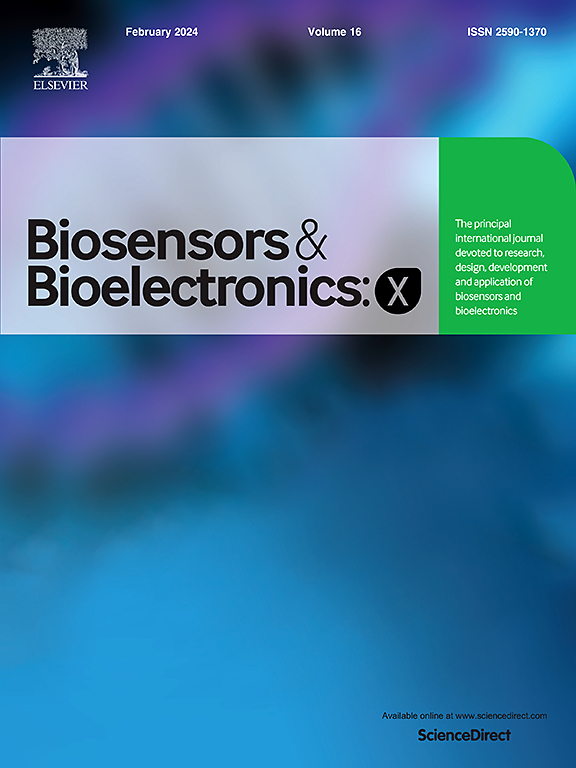Integrating voltammetry and substrate-enhanced luminescence for noninvasive glucose sensing
IF 10.61
Q3 Biochemistry, Genetics and Molecular Biology
引用次数: 0
Abstract
This study presents a novel noninvasive and enzyme-free dual sensor based on porous silicon (PSi) for the detection of D-glucose through tear fluid analysis. The sensor incorporates NaGdF4:20% Yb3+, 2% Er3+ nanoparticles (YbEr-NPs) immobilized on a PSi substrate functionalized with a phenylboronic ester molecule. The YbEr-NPs enable luminescence-based sensing, exploiting the sensitivity of Er3+ ions to the OH vibrational groups present in D-glucose. Electrodes fabricated on a PSi substrate allow for voltammetric analysis, providing a second detection method. The voltammetric sensor achieved a limit of detection (LoD) of 20 mg/dL in the range of 20–200 mg/dL, which is suitable for detecting D-glucose concentrations in the tear fluid of diabetic patients. The luminescence-based sensor, utilizing the red-to-green emission ratio of YbEr-NPs, reached a LoD of 140 mg/dL in the range of 10–70 mg/dL, covering the hyperglycemic range. The interaction between the YbEr-NPs and the PSi substrate led to the appearance of new emission bands and increased intensity, attributed to surface defects acting as an additional excitation source. The 556 nm emission band showed a strong dependence on the D-glucose concentration, improving the LoD to 110 mg/dL. This provides a novel strategy for D-glucose detection based on the effect of the molecule on the interaction between the Rare-earth-doped nanoparticles and the PSi substrate. This triple-sensing approach offers a promising solution for noninvasive glucose monitoring, enabling detection in both the hypoglycemic and hyperglycemic ranges.
集成伏安法和底物增强发光的无创葡萄糖传感
本研究提出了一种基于多孔硅(PSi)的新型无创无酶双传感器,用于通过泪液分析检测d -葡萄糖。该传感器将NaGdF4:20% Yb3+, 2% Er3+纳米颗粒(YbEr-NPs)固定在苯基硼酯分子功能化的PSi底物上。YbEr-NPs利用Er3+离子对d -葡萄糖中存在的OH振动基团的敏感性,实现了基于发光的传感。在PSi衬底上制造的电极允许伏安分析,提供第二种检测方法。伏安传感器在20 ~ 200 mg/dL范围内的检出限为20 mg/dL,适用于糖尿病患者泪液中d -葡萄糖浓度的检测。基于发光的传感器,利用YbEr-NPs的红绿发射比,在10-70 mg/dL范围内达到140 mg/dL的LoD,覆盖了高血糖范围。YbEr-NPs和PSi衬底之间的相互作用导致了新的发射带的出现和强度的增加,这归因于表面缺陷作为额外的激发源。556nm的发射波段对d -葡萄糖浓度有很强的依赖性,将LoD提高到110 mg/dL。这为基于分子对稀土掺杂纳米颗粒与PSi底物之间相互作用的影响的d -葡萄糖检测提供了一种新的策略。这种三重感应方法为无创血糖监测提供了一种有前途的解决方案,可以在低血糖和高血糖范围内进行检测。
本文章由计算机程序翻译,如有差异,请以英文原文为准。
求助全文
约1分钟内获得全文
求助全文
来源期刊

Biosensors and Bioelectronics: X
Biochemistry, Genetics and Molecular Biology-Biophysics
CiteScore
4.60
自引率
0.00%
发文量
166
审稿时长
54 days
期刊介绍:
Biosensors and Bioelectronics: X, an open-access companion journal of Biosensors and Bioelectronics, boasts a 2020 Impact Factor of 10.61 (Journal Citation Reports, Clarivate Analytics 2021). Offering authors the opportunity to share their innovative work freely and globally, Biosensors and Bioelectronics: X aims to be a timely and permanent source of information. The journal publishes original research papers, review articles, communications, editorial highlights, perspectives, opinions, and commentaries at the intersection of technological advancements and high-impact applications. Manuscripts submitted to Biosensors and Bioelectronics: X are assessed based on originality and innovation in technology development or applications, aligning with the journal's goal to cater to a broad audience interested in this dynamic field.
 求助内容:
求助内容: 应助结果提醒方式:
应助结果提醒方式:


